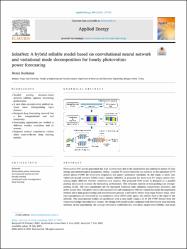| dc.contributor.author | Korkmaz, Deniz | |
| dc.date.accessioned | 2021-08-22T08:54:50Z | |
| dc.date.available | 2021-08-22T08:54:50Z | |
| dc.date.issued | 2021 | en_US |
| dc.identifier.citation | Korkmaz, D. (2021). SolarNet: A hybrid reliable model based on convolutional neural network and variational mode decomposition for hourly photovoltaic power forecasting. Applied Energy, 300, 117410. | en_US |
| dc.identifier.issn | 0306-2619 | en_US |
| dc.identifier.uri | https://doi.org/10.1016/j.apenergy.2021.117410 | |
| dc.identifier.uri | https://hdl.handle.net/20.500.12899/344 | |
| dc.description | Malatya Turgut Ozal University, Faculty of Engineering and Natural Sciences, Department of Electrical and Electronics Engineering, Malatya 44210, Turkey | en_US |
| dc.description.abstract | Photovoltaic (PV) power generation has high uncertainties due to the randomness and imbalance nature of solar energy and meteorological parameters. Hence, accurate PV power forecasts are essential in the operation of PV power plants (PVPP) for short-term dispatches and power generation schedules. In this study, a novel convolutional neural network (CNN) model, namely SolarNet, is proposed for short-term PV output power forecasting under different weather conditions and seasons. The proposed CNN model is designed as a parallel pooling structure to increase the forecasting performance. This structure consists of max-pooling and average-pooling blocks. The input parameters are the measured historical solar radiation, temperature, humidity, and active power data. The power data is decomposed into sub-components with the variational mode decomposition method and a data preprocessing and reconstruction process is utilized to obtain deep input feature maps. After input parameters are converted to hue-saturation-value (HSV) color space, the subsets feed to the input of the network. The experimental studies are performed with a case study using a 23.40 kW PVPP dataset from the Desert Knowledge Australia Solar Centre. The design CNN model is also compared with benchmark deep learning methods. In the experiments, the average correlation coefficient (R), root mean square error (RMSE), and mean absolute error (MAE) of the proposed method for 1-h different weather conditions are achieved as 0.9871, 0.3090, and 0.1750, respectively. The experimental results show that the proposed deep forecasting method has higher accuracy and stability in short-term PV power forecasting and outperforms the other deep learning methods. | en_US |
| dc.language.iso | en | en_US |
| dc.publisher | Elsevier | en_US |
| dc.relation.ispartof | Applied Energy | en_US |
| dc.rights | info:eu-repo/semantics/closedAccess | en_US |
| dc.subject | Photovoltaic power forecasting | en_US |
| dc.subject | Convolutional neural network | en_US |
| dc.subject | Parallel pooling | en_US |
| dc.subject | Variational mode decomposition | en_US |
| dc.subject | Deep learning | en_US |
| dc.title | SolarNet: A hybrid reliable model based on convolutional neural network and variational mode decomposition for hourly photovoltaic power forecasting | en_US |
| dc.type | Article | en_US |
| dc.authorid | 0000-0002-5159-0659 | en_US |
| dc.department | MTÖ Üniversitesi, Mühendislik ve Doğa Bilimleri Fakültesi, Elektrik-Elektronik Mühendisliği Bölümü | en_US |
| dc.institutionauthor | Korkmaz, Deniz | |
| dc.identifier.doi | 10.1016/j.apenergy.2021.117410 | |
| dc.identifier.volume | 300 | en_US |
| dc.identifier.startpage | 1 | en_US |
| dc.identifier.endpage | 20 | en_US |
| dc.relation.publicationcategory | Makale - Uluslararası Hakemli Dergi - Kurum Öğretim Elemanı | en_US |
| dc.identifier.scopus | 2-s2.0-85110283544 | en_US |
| dc.identifier.scopusquality | Q1 | en_US |
| dc.identifier.wos | WOS:000684860700005 | en_US |
| dc.identifier.wosquality | Q1 | en_US |
| dc.indekslendigikaynak | Web of Science | en_US |
| dc.indekslendigikaynak | Scopus | en_US |


















